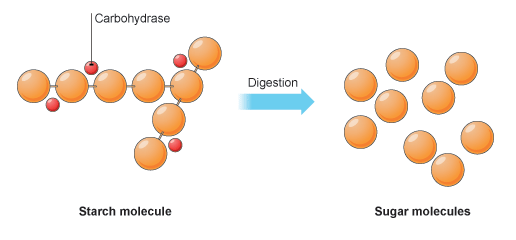Tagged: maltose
Starch Digestion: Grade 9 Understanding for IGCSE Biology 2.29
You must remember that “Digestion” has a specific meaning in Biology. It is the term used for the process that involves the chemical breakdown of large, insoluble food molecules into smaller, simpler molecules that can be absorbed into the blood. Many of the molecules in food are polymers – that is macromolecules made from long chains of repeating subunits. Examples of dietary macromolecules include proteins, polysaccharides and fats. These molecules are too large to be able to pass into the blood in the villi of the small intestine and so the body has evolved to chemically break them down into their constituent monomers or building blocks. Digestion is the process in the alimentary canal that achieves this.
Digestion reactions are also known as hydrolysis reactions because a molecule of water is required in the reaction to break the covalent bond holding the monomers together. These reactions are all catalysed (sped up) by specific molecules called digestive enzymes.
Why do different food types need different digestive enzymes to speed up their breakdown in the digestive system?
(If you are unsure, you need to revise the way enzymes work to catalyse reactions by a “lock and key” theory?)
Digestion of Carbohydrates
Many simple carbohydrates (e.g. glucose) do not need digesting. This is because they are already small enough to be absorbed into the blood directly in the ileum (small intestine). But larger disaccharide sugars (e.g. maltose and sucrose) do need to be broken down, as do all polysaccharides (e.g starch).
The family of enzymes that break down carbohydrates are called carbohydrases.

Starch is a large polysaccharide made up of many hundreds of glucose residues linked together. It is way too big to be able to cross the epithelial lining of the small intestine and so needs to be digested. This happens in a two-stage process. Firstly there is an enzyme amylase that can catalyse the following reaction:
starch + water ——-> maltose
Amylase is made in the salivary glands and so works in the mouth. But the main region for the digestion of starch is in the duodenum. This is because amylase is also made in the pancreas.
Maltose is a disaccharide molecule made of two glucose residues joined together. Maltose itself requires digesting to its constituent glucose molecules in order to be absorbed. So the second stage in the digestion of starch involves a second enzyme, maltase that is found embedded into the epithelial lining of the ileum. Maltase catalyses the breakdown of a molecule of maltose into two molecules of glucose which can be absorbed into the blood.
maltose + water ——> glucose

Starch Digestion: Grade 9 Understanding for IGCSE Biology 2.29
You must remember that “Digestion” has a specific meaning in Biology. It is the term used for the process that involves the chemical breakdown of large, insoluble food molecules into smaller, simpler molecules that can be absorbed into the blood. Many of the molecules in food are polymers – that is macromolecules made from long chains of repeating subunits. Examples of dietary macromolecules include proteins, polysaccharides and fats. These molecules are too large to be able to pass into the blood in the villi of the small intestine and so the body has evolved to chemically break them down into their constituent monomers or building blocks. Digestion is the process in the alimentary canal that achieves this.
Digestion reactions are also known as hydrolysis reactions because a molecule of water is required in the reaction to break the covalent bond holding the monomers together. These reactions are all catalysed (sped up) by specific molecules called digestive enzymes.
Why do different food types need different digestive enzymes to speed up their breakdown in the digestive system?
(If you are unsure, you need to revise the way enzymes work to catalyse reactions by a “lock and key” theory?)
Digestion of Carbohydrates
Many simple carbohydrates (e.g. glucose) do not need digesting. This is because they are already small enough to be absorbed into the blood directly in the ileum (small intestine). But larger disaccharide sugars (e.g. maltose and sucrose) do need to be broken down, as do all polysaccharides (e.g starch).
The family of enzymes that break down carbohydrates are called carbohydrases.

Starch is a large polysaccharide made up of many hundreds of glucose residues linked together. It is way too big to be able to cross the epithelial lining of the small intestine and so needs to be digested. This happens in a two-stage process. Firstly there is an enzyme amylase that can catalyse the following reaction:
starch + water ——-> maltose
Amylase is made in the salivary glands and so works in the mouth. But the main region for the digestion of starch is in the duodenum. This is because amylase is also made in the pancreas.
Maltose is a disaccharide molecule made of two glucose residues joined together. Maltose itself requires digesting to its constituent glucose molecules in order to be absorbed. So the second stage in the digestion of starch involves a second enzyme, maltase that is found embedded into the epithelial lining of the ileum. Maltase catalyses the breakdown of a molecule of maltose into two molecules of glucose which can be absorbed into the blood.
maltose + water ——> glucose

